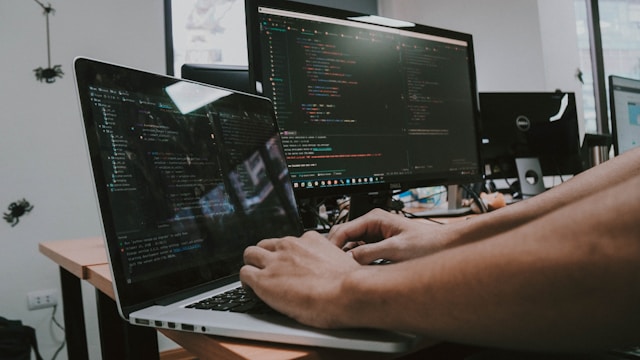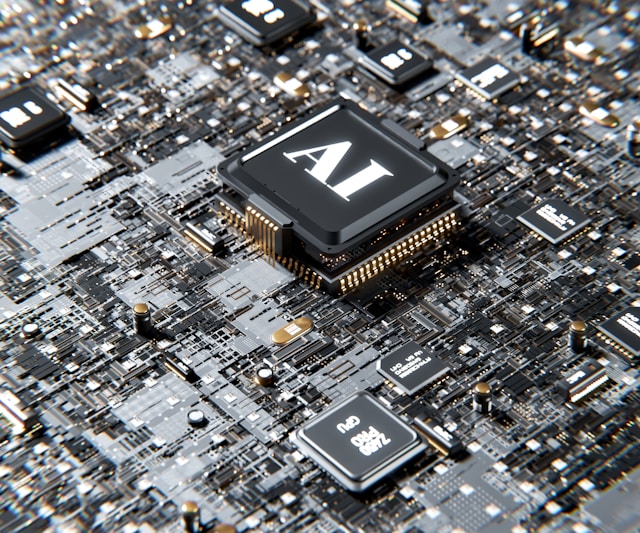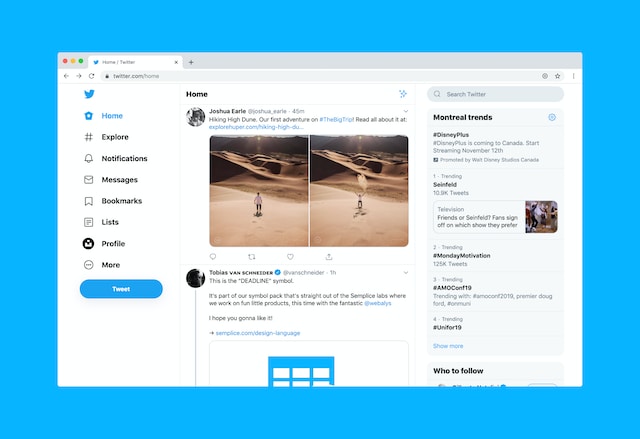AI in cybersecurity is invaluable, as this technology will change the face of the security landscape in the coming decade. On the one hand, they give you the power to be proactive and quickly respond to digital threats and attacks. However, cybercriminals also have access to this technology, making it easier to engage in malicious activities.
As this critical technology develops and improves, it’s time to take a closer look. Let’s understand how the cybersecurity industry uses this tech, what tools are available, and the problems they pose.

Table of Contents
AI Cybersecurity Threats: 3 Ways Cybercriminals Leverage This Technology
Cybercriminals also have their hands on artificial intelligence (AI) powered tools. This gives them the means to carry out complex attacks. Below are three AI cybersecurity threats you must know about.
1. Sophisticated Social Engineering Techniques
Humans are always the weakest link, even if you have state-of-the-art infrastructure to detect and prevent cyberattacks. Social engineering is a method to extract private information or gain access to secure systems and networks. Cybercriminals use this technique as it is exceptionally effective in helping them achieve their nefarious goals.
Bad actors can quickly create content using various AI tools. They will then use such content to trick people into doing things they usually wouldn’t do.
For example, cybercriminals pretend to be from the Internal Revenue Service (IRS). They can generate content that looks legitimate and formal with AI tools, asking you to pay your dues. Bad actors may call you and use fake audio to convince you that you’re actually dealing with the IRS.
2. High-Quality Deepfakes
Cybercriminals use AI deepfakes to create numerous cybersecurity-related problems. Bad actors can use this technology to impersonate high-profile individuals. Distributing this type of content is simple. Also, people can easily assume these fake photos and videos are real.
Usually, cybercriminals use this technology along with social engineering techniques to ensure their attacks are effective.
There are also real-world examples of bad actors using deepfakes to trick businesses and individuals. For example, a multinational company transferred $25 million to cybercriminals after they deepfaked the organization’s chief financial officer. These individuals created fake personas of real people and used this technology in a video call.
Similarly, Taylor Swift was part of a deepfake attack on X. Bad actors created fake images of the pop star and distributed them on X, now Twitter.
3. Target AI Tools With Data Poisoning Techniques
AI is heavily reliant on the data you provide to produce accurate results. If there are errors in these data sets, the outputs become inaccurate. Cybercriminals can poison the data these tools use to create backdoors.
For example, a company uses an AI tool to reduce emails containing spam and malicious content. Hackers can poison the data this organization uses to train and improve this tool. Over time, they can get this tool to allow emails with malicious links. This enables the bad actors to gain unauthorized access when an unsuspecting employee visits the URL in the email.
Hackers can also poison datasets to ensure that AI tools give them private information with specific prompts.

How Can Generative AI Be Used in Cybersecurity: 3 Use Cases of This Technology
Generative AI can craft content, like videos, audio, images, and text. For example, Open AI’s ChatGPT and Google’s Gemini are real-life examples of this technology. How can generative AI be used in cybersecurity?
Below are three ways experts and organizations use this technology to keep themselves secure.
1. Analyzing and Discovering Suspicious User Behavior
With machine learning techniques, you can create behavior profiles of your organization’s employees. They are the baseline for how people will behave when using your company’s devices.
With these models, AI tools can look for outliers and bring them to the attention of the business’s security analysts. These professionals can then think of how to prevent these types of cyberattacks from happening in the future.
Similarly, let’s say you have a tool for detecting bots on your website. Bots have a negative impact on user experience (UX), as they tend to overwhelm available resources. People may notice your website loads slowly, or other services don’t work.
By studying and analyzing bot activity, these tools can detect similar behavior and block these visitors immediately.
2. Decrease the Time To Respond to Cyberattacks
Cyberattacks happen quickly, and it takes time for cybersecurity teams to respond. The faster these teams can react, the better it is for the organization. AI security tools can help improve the response time.
For starters, when an organization suffers from an attack, this technology can collect and classify relevant data. It can also create reports and simplify the information. Cybersecurity teams can review these reports and understand the next course of action.
Companies can use these tools to study the patterns of previous attacks and how they responded to these threats. Over time, this technology can suggest the best course of action if the organization suffers from a similar cyberattack.
3. Recognize Grounds for Potential Threats
Most cyberattacks you encounter use older source codes and frameworks as their foundations. However, humans find it challenging to detect similar threats and respond in time. This is where AI can help improve cybersecurity.
It learns from various attack datasets and compares them with new threats to look for what’s common between the two. This makes recognizing potential threats easier and taking the necessary safety measures to prevent such attacks.

3 Disadvantages of AI in Cybersecurity
Although AI shows a lot of promise, it has its fair share of downsides. Below are three disadvantages of AI in cybersecurity.
1. It Is Vulnerable To Bad Datasets
Datasets are the lifeblood of AI technologies, as they rely on this information to make reliable decisions. As highlighted earlier, the problem is that bad actors can manipulate this data. Also, AI tools can provide unreliable results if you feed them the wrong datasets.
This introduces biases and also causes false positives to become the norm. For example, an AI-powered email filtering tool can ensure people don’t see spam mail in their dashboards. However, due to bad data, it removes any email with a link, as it assumes this message is spam. Or it can misclassify staff as bad actors, lock them out of their systems, and waste their time.
2. It Increases the Rate of Evolution and Speed of Cyberattacks
Cybersecurity professionals already have to deal with threats that continue to evolve and become sophisticated. With AI technology, cybercriminals have the tools to increase this rate of evolution. They learn new techniques, deploy complex attacks, and target various organizations quickly.
AI makes it harder to adapt to the ever-changing nature of cyberattacks. Older security measures fall into the outdated category, so developers must develop new solutions regularly.
3. It Still Requires Human Intelligence
Although this technology is incredibly powerful, it still needs the input of humans to be truly effective. For starters, people have to provide these tools with the necessary datasets. Also, humans must get to the bottom of any issue they face while using this technology.
If people become complacent, these tools can also become ineffective over time. For starters, bad datasets introduce biases in the output, making the results inaccurate. Similarly, if humans don’t detect and correct the errors, the technology will continue making the same mistakes.

2 AI-Based Cybersecurity Tools You Should Use Today
Integrating AI-based cybersecurity tools into your existing infrastructure is essential to keeping yourself secure. Below is a list of two effective tools you should use.
1. Vectra AI
Vectra AI is a reliable cybersecurity tool that uses AI. It is easy to integrate this technology with your existing framework. This tool assigns scores to various threats vectors to help you prioritize and fix them quickly.
The company has 35 patents for detecting threats and is confident with what it can do for your network security. It also helps your team handle real-time attacks and reduces the number of irrelevant alerts.
2. Darktrace
Darktrace is an AI-based cybersecurity tool that’s always active and looking for attacks. You can use this to monitor your network, emails, apps, cloud services, and more. It continues to learn and improve after you deploy it with your infrastructure.
It gives your security teams adequate breathing room, as it can detect and fight various threats. This tool learns what’s normal in your company and flags unusual activities.

TweetDelete Prevents the Mistakes of Generative AI From Damaging Your Credibility
Generative AI in cybersecurity has immense potential, which will become apparent as this technology improves. These tools augment your security team’s decision-making process while reducing their time doing mundane activities.
Although generative AI is incredible, it has a lot of problems in its current state. These AI tweet generators tend to hallucinate, i.e., generate misinformation. The problem is that these services can make even misinformation look convincing.
Publishing tweets with such content can damage your credibility, especially when trying to position yourself as a cybersecurity expert. With TweetDelete, this really won’t be a problem, as you have the tools to take down thousands of posts quickly.
How do you do this? First, you need to run the custom filter to find all the posts with AI-generated content. The next step is to use the mass-delete tweets utility to remove them from your profile page on X.
What if you don’t have the time to remove posts about AI in cybersecurity? In this situation, the auto-delete task is all you’ll ever need. It will ask you for specific keywords and a date range to find tweets with AI content.
You can also delete every post in your profile just to be on the safer side with this tool.
Prevent the mistakes of generative AI from affecting your credibility on X, formerly Twitter, by using TweetDelete today!











